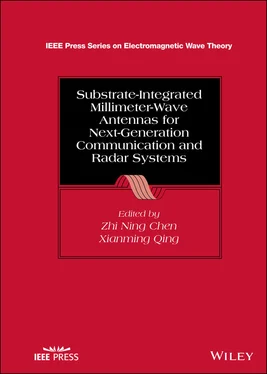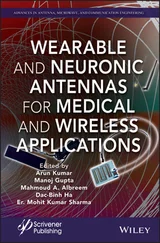The book will have widespread appeal to practicing engineers, research scholars, and postgraduate students. I would like to congratulate Professor Zhi Ning Chen and his co‐authors on the production of this important text, which will be of great benefit to the antenna community globally.
Professor Kwai‐Man Luk FREng, FIEEE
City University of Hong Kong
Millimeter‐wave technologies have a long history. In early 2000, the topic became hot again due to the unlicensed 60‐GHz wireless communications for short‐range links (later IEEE 802.11ad). As antenna researchers we thought how we can contribute to the research and development of the new wave of millimeter‐wave systems. After the comprehensive study of the unique challenges of antenna design at millimeter‐wave bands, we decided to focus on three issues: loss control, integration, and testing setups. Since 2008 we have conducted the loss analysis of all designs and proposed technologies to control the losses caused by materials, surface waves, and feeding structures. We have explored almost all ways to integrate the antennas and arrays into a variety of substrate from printed circuit board (PCB), low‐temperature co‐fired ceramic (LTCC), to integrated circuit package (IC package). We also configured and built up three measurement systems to test the impedance, radiation pattern, and gain of the antennas from 60 GHz to 325 GHz. Our works have been widely recognized with tens of papers published in prestigious journals, filed patents, and completed industry projects.
With the deployment of millimeter‐wave technology in 5G, the research and development of antenna technologies at millimeter‐wave bands are fast advancing to industry applications. The technologies we developed for alleviating fundamental challenges should have more opportunities to be further developed and applied.
The major contents of the book stem from the works of millimeter‐wave antennas in the past decade when the editors as well as the authors worked in Institute of Infocomm Research (I2R), Singapore. The relevant research and development were fully supported by Agency for Science, Technology and Research (A*STAR).
The team has worked hard to complete this project in a short duration. All authors would like to appreciate their colleagues as well as their family members for their generous support when they were preparing the manuscripts, in particular, during the COVID‐19 period.
Zhi Ning Chen, National University of Singapore
Xianming Qing, Institute for Infocomm Research, Singapore
1
Introduction to Millimeter Wave Antennas
Zhi Ning Chen
Department of Electrical and Computer Engineering, National University of Singapore, Singapore, 117583, Republic of Singapore.
Millimeter waves are regulated by the International Telecommunication Union (ITU) as the electromagnetic waves at the wavelength range of millimeter order, namely, 1–10 mm; the corresponding frequency range is from 30 to 300 GHz, or extremely high frequency (EHF), as listed in Table 1.1. However, the systems operating at the frequencies lower than 30 GHz, such as 24 GHz, are also categorized as millimeter wave (mmW) systems simply because the behaviors of the electromagnetic waves at such frequencies are very similar to those at the defined mmW frequencies. Furthermore, the waves at the wavelength of sub‐millimeter order, namely 0.1–1 mm, or the frequency range from 300 to 3000 GHz, are regulated as “terahertz (THz) wave,” and the waves at the wavelength of 1 mm–1 m, or the frequency range from 300 MHz to 300 GHz, are regulated as “microwave” by ITU [1]. Therefore, the mmW band is located at the upper edge of the microwave band. Accordingly, the wavelengths at the mmW bands are shorter than those at lower microwave bands but longer than those at infrared bands.
The majority of existing wireless communication and radar systems have been long operating at the lower microwave bands. This book will focus on the waves over the mmW bands at the frequency range from 24 to 300 GHz for wireless applications.
1.2 Propagation of Millimeter Waves
The high frequencies or short wavelengths of the mmWs make their propagation characteristics very unique. The propagation characteristics directly determine the behaviors of waves propagating to desired destinations through a certain path and media. In a long‐distance wireless communication, radar, or imaging/sensing application, the propagation properties of the wave fully determine the system design requirements, in particular the selection of the adequate operating frequency and bandwidth [2].
As shown in Table 1.2, the dominant propagation modes of the waves vary against operating frequencies. Furthermore, the types of propagation modes determine the distance of wave propagation. It can be found that:
1 the wave mainly propagates in ionospheric modes like a skywave when the frequencies are lower, for instance, at very high frequency (VHF) and below;
2 the wave can propagate in surface modes like a groundwave when the frequencies are at low frequency (LF) to high frequency (HF) bands; and
3 at higher frequencies, typically VHF and above, the wave just travels in direct modes, that is, the line‐of‐sight (LOS), where the propagation is limited by the visual horizon up to about 64 km on the surface of the earth.
Table 1.1 Allocation of the radio frequency bands by ITU.
| ITU band number |
Designated band |
Frequency |
Wavelength in air |
| 1 |
Extremely low frequency (ELF) |
3–30 Hz |
9993.1–99 930.8 km |
| 2 |
Super low frequency (SLF) |
30–300 Hz |
999.3–9993.1 km |
| 3 |
Ultra low frequency (ULF) |
300–3000 Hz |
99.9–999.3 km |
| 4 |
Very low frequency (VLF) |
3–30 kHz |
10.0–99.9 km |
| 5 |
Low frequency (LF) |
30–300 kHz |
1.0–10.0 km |
| 6 |
Medium frequency (MF) |
300–3000 kHz |
0.1–1.0 km |
| 7 |
High frequency (HF) |
3–30 MHz |
10.0–100.0 m |
| 8 |
Very high frequency (VHF) |
30–300 MHz |
1.0–10.0 m |
| 9 |
Ultra high frequency (UHF) |
300–3000 MHz |
0.1–1.0 m |
| 10 |
Super high frequency (SHF) |
3–30 GHz |
10.0–100.0 mm |
| 11 |
Extremely high frequency (EHF) |
30–300 GHz |
1.0–10.0 mm |
| 12 |
Tremendously high frequency (THF or THz) |
300–3000 GHz |
0.1–1.0 mm |
Note:
1 Hz: hertz
2 k: kilo (103), M: mega (106), G: giga (109), T: tera (1012).
The LOS refers to the waves directly propagating in a line from one transmitting antenna to the receiving antenna. However, it is not necessary for the wave to travel in a clear sight path. Usually, the wave is able to go through buildings, foliage, and other obstacles with diffraction or reflection, in particular at lower frequencies such as VHF and below.
On the other hand, like a light wave, also an electromagnetic wave, the mmWs with shorter wavelengths in millimeter orders, in particular, at EHF and above, always propagate in LOS modes. Their propagation is significantly affected by the typical phenomena of reflection, refraction, diffraction, absorption, and scattering so that a clear path without any lossy or/and wavelength comparable obstacles in the traveling path is required. Such a propagation feature of waves will be reflected in the design considerations of antennas in mmW systems.
Читать дальше












